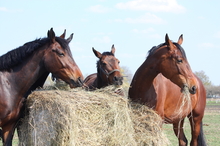A discovery by University of Guelph researchers lead by Dr. Dorothee Bienzle, Department of Pathobiology will help in understanding how horses develop recurrent airway obstruction (RAO) and offers hope of potential solutions for people with asthma.

Hay as contributor to respiratory disease in horses
Research into genes in horses that produce a certain protein may lead to treatment for both recurrent airway obstruction and also asthma in people.
In a paper in a recent issue of BMC Genomics, the researchers discuss their discovery that horses have three copies of a gene normally found as a single copy in mammals. This gene, called secretoglobin family 1A member 1 (SCGB-1A1), produces a protein secreted in large amounts in the airway.
RAO is a chronic inflammatory lung disease. It is especially prevalent during winter in horses kept in barns and fed hay. The researchers found that RAO-susceptible horses have much less SCGB1A1 protein in their airways, which enhances inflammation.
Symptoms in horses with RAO resemble those of humans with environmentally induced asthma.
The researchers found that two of the gene copies could play a significant role in treating RAO. The third copy has no recognized function and may have evolved into a pseudo-gene.
Lead author Olivier Côté, a PhD candidate in the Department of Pathobiology, says the study could have larger implications than treating horses.
“We’re able to use the horse as a model for asthma in humans,” said Côté. “We found through our research that horses suffering from RAO had reduced SCGB1A1 levels. Since an obvious suggestion for treating RAO is to increase protein levels of SCGB1A1, we made a synthetic version of it in the lab. We are currently testing the protein’s function. While it would not be possible to simply provide humans with this protein to reduce asthma, as humans and horses are different species, these findings do give hope that we can find novel treatments for asthma.”
Study co-author Prof. Dorothee Bienzle said it was challenging to isolate and assess the individual genes. The researchers also faced challenges because of the unusual nature of the gene triplication.
“Other mammals do not have multiple SCGB1A1 copies, except for some other equidae, such as Przewalski’s horses and donkeys,” she said. “So it is difficult to know where the gene came from. We can speculate that it was an evolutionary response that took place over many years. We don’t know why the pseudo-gene exists or what its purpose is. The distribution of the other two gene transcripts and proteins indicates they are extremely prevalent in the lung and reproductive organs.”
Looking at 24 horses, the researchers found that one gene variant was about 2.5 times more prevalent than the second copy in most animals. In horses with RAO, that ratio significantly increased, suggesting abnormal regulation of the two copies.
“We hope that our finding will lead to improved treatment of horses with RAO,” said Côté. “Future studies will assess the function of different SCGB1A1 proteins and attempt to uncover their anti-inflammatory properties. If the results are positive, this would comprise a stepping stone toward treatment of asthma in people.”
